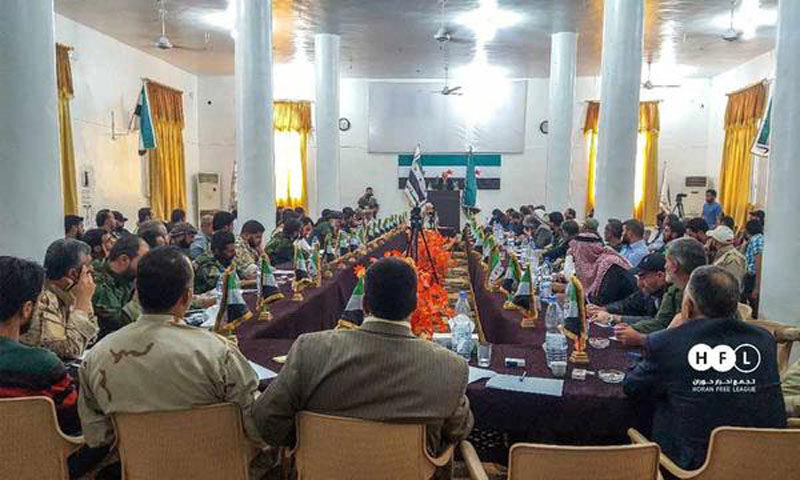Meeting between civil and rebel representatives in the southern region attempts to settle differences in the military, civilian and judicial sectors, Enab Baladi writes
Rebel groups and authorities in Daraa are attempting to reshuffle the cards of the province, following a broad meeting between most of the province’s armed opposition groups and civilian authorities in the city of Bosra al-Sham on Thursday.
Questions emerged from residents about the aim of the meeting and whether it was organized under foreign pressure or if it was a serious effort to attempt to heal the rift in the military, civilian and judicial sectors in southern Syria.
The meeting’s closing statement, which was delivered by international legal expert Dr. Mansour al-Nasser, said that “southern Syria is an integral part of the revolution,” stressing the “confirmation of the revolution’s aims and constants.”
The meeting also approved the formation of a preparatory committee to work on establishing a joint military leadership for the southern region, in addition to forming a committee composed of a “reform authority,” and a “united Islamic authority,” and a lawyers association, as well as military groups, to communicate with the Dar al-Adel (House of Justice) court with the aim of restructuring it.
The attendees rejected any deal to reopen the Naseeb border crossing “without the achievement of the aims of the revolution and its constants,” and said that “the internal military decision would be decided by groups working on the ground.”
Head of the Dar al-Adel responds
The head of the Dar al-Adel in Houran, Esmat al-Abasi, did not attend the meeting, but he did respond to the formation of the committee to restructure the court, telling Enab Baladi that “restructuring is the purview of the High Judicial Council of Syria only, but our doors and hearts are open to all constructive advice and criticism.”
He added: “Of the four parties noted in the closing statement, we are members of some of them, and we have full respect and appreciation for them … we will listen to them and accept their advice.”
According to activists from Daraa, if the major rebel factions agreed, they would be able to impose their decision regarding the restructuring.
The first changes in the province began with a decision to dissolve the Southern Front, with their number reduced to about 3,000 fighters after southern Syria entered into the “de-escalation” zones on July 9.
The region is heading towards new changes away from other Syrian regions, under a Jordanian-American leadership, in a move considered by analysts to represent the total hegemony of the two countries although with the agreement of rebel groups.
The current trends come amid uncertainty regarding the fate of the Southern Front groups after the decision taken by the Amman-based Military Operations Center to dissolve it and restructure groups in Daraa and Quneitra, under the direction of four formations that have not been named yet, according to Enab Baladi’s sources.
Observers believe that the coming days will still be blurry for southern Syria, amid a clear fragmentation between civilian and military institutions, as some believe each entity is “pulling the rope for its side.” This has become especially apparent since the formation of the civilian institutions for the High Administration Authority in July, which is yet to bring anything new to the region.
This article was translated and edited by The Syrian Observer. Responsibility for the information and views set out in this article lies entirely with the author.
